This article contains promotional content .(December 2024) |
Liquin is a quick-drying medium for oil and alkyd paint. Used as an additive in many forms of artwork, Liquin is produced by Winsor & Newton and has a number of uses.
This article contains promotional content .(December 2024) |
Liquin is a quick-drying medium for oil and alkyd paint. Used as an additive in many forms of artwork, Liquin is produced by Winsor & Newton and has a number of uses.
This section needs additional citations for verification .(December 2024) |
Alkyd resin medium for artists was first invented in the 1970s by Arthur DeCosta, a longtime professor at The Pennsylvania Academy of the Fine Arts in Philadelphia. DeCosta's medium, Turco Classic, was sold only locally at the Academy's school store, the Philadelphia Utrecht Linen art supply store, and one or two other privately owned art supply stores. DeCosta believed his medium had similar qualities to Maroger medium (Jacques Maroger), the fast drying, supposed medium of the Old Masters. Because Maroger medium must be cooked with lead, Turco lacked its inherent danger and had a similar, if not faster, drying time.
"The Kid," as DeCosta called the young man responsible for the manufacture of Turco, often made poor batches of the product and DeCosta, being a full-time professor as well as a prominent Philadelphia painter (notable for his portrait of former mayor Frank Rizzo), gave up on the enterprise sometime in the early 1980s. Since then many companies have produced similar products, Liquin being the most popular.
Winsor & Newton suggests the use of Liquin as a ''fat'' or ''flexible'' agent, to increase the flexibility subsequent layers. [1] While Liquin Original, [2] and Liquin Light Gel Medium [3] are mixtures of petroleum distillates, Liquin Oleopasto, [4] and Liquin Impasto [5] are mixtures of alkyd resin and petroleum distillates.
This section needs additional citations for verification .(December 2024) |
Notably, it is used to speed the drying time in oil painting, though it may also be used as a barrier layer to achieve some effects. Painted over the top of etchings, India-ink drawings and other line art, it enables the application of colours by tinting with thin glazes of oil paint. This technique was first discovered by the artist Patrick Woodroffe and is outlined in his book A Closer Look (Paper Tiger, 1986, ISBN 1-85028-025-8).
Liquin also permits the creation of "save" layers in painting.
Painted over all, or part, of an artwork in progress (and left to dry), Liquin allows the artist to scrape or wipe back subsequent work to the Liquin layer, while preserving all work beneath.
It can also be used as a simple carrier base and, when compressed together with paint under a layer of plastic wrap, produces effective decalcomania.
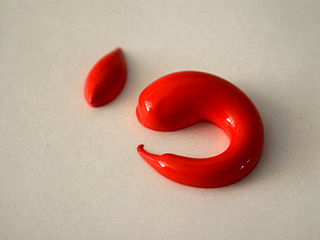
Acrylic paint is a fast-drying paint made of pigment suspended in acrylic polymer emulsion and plasticizers, silicone oils, defoamers, stabilizers, or metal soaps. Most acrylic paints are water-based, but become water-resistant when dry. Depending on how much the paint is diluted with water, or modified with acrylic gels, mediums, or pastes, the finished acrylic painting can resemble a watercolor, a gouache, or an oil painting, or it may have its own unique characteristics not attainable with other media.
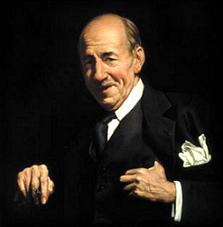
Jacques Maroger was a painter and the technical director of the Louvre Museum's laboratory in Paris. He devoted his life to understanding the oil-based media of the Old Masters. He emigrated to the United States in 1939 and became an influential teacher. His book, The Secret Formulas and Techniques of the Masters, has been criticized by some modern writers on painting who say that the painting medium Maroger promoted is unsound.

Oil painting is a painting method involving the procedure of painting with pigments with a medium of drying oil as the binder. It has been the most common technique for artistic painting on canvas, wood panel or copper for several centuries, spreading from Europe to the rest of the world. The advantages of oil for painting images include "greater flexibility, richer and denser color, the use of layers, and a wider range from light to dark". But the process is slower, especially when one layer of paint needs to be allowed to dry before another is applied.

Paint is a material or mixture that, when applied to a solid material and allowed to dry, adds a film-like layer. As art, this is used to create an image or images known as a painting. Paint can be made in many colors and types. Most paints are either oil-based or water-based, and each has distinct characteristics.

Impasto is a technique used in painting, where paint is laid on an area of the surface thickly, usually thick enough that the brush or painting-knife strokes are visible. Paint can also be mixed right on the canvas. When dry, impasto provides texture; the paint appears to be coming out of the canvas.
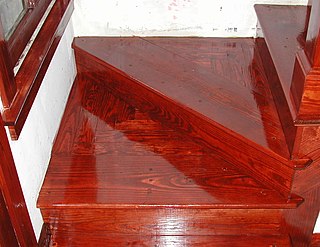
Varnish is a clear transparent hard protective coating or film. It is not to be confused with wood stain. It usually has a yellowish shade due to the manufacturing process and materials used, but it may also be pigmented as desired. It is sold commercially in various shades.

Linseed oil, also known as flaxseed oil or flax oil, is a colorless to yellowish oil obtained from the dried, ripened seeds of the flax plant. The oil is obtained by pressing, sometimes followed by solvent extraction.

Oil paint is a type of slow-drying paint that consists of particles of pigment suspended in a drying oil, commonly linseed oil. Oil paint also has practical advantages over other paints, mainly because it is waterproof.
Water-miscible oil paint is oil paint either engineered or to which an emulsifier has been added, allowing it to be thinned and cleaned up with water. These paints make it possible to avoid using, or at least reduce volatile organic compounds such as turpentine that may be harmful if inhaled. Water-miscible oil paint can be mixed and applied using the same techniques as traditional oil-based paint, but while still wet it can be removed from brushes, palettes, and rags with ordinary soap and water. One of the ways its water solubility comes from is the use of an oil medium in which one end of the molecule has been engineered to be hydrophilic and thus bind loosely to water molecules, as in a solution. This type of paint is different to those that are engineered to enable cleaning of brushes and application equipment in water but are not in themselves water reducible.
Fat over lean refers to the principle in oil painting of applying paint with a higher oil to pigment ratio ('fat') over paint with a lower oil to pigment ratio ('lean') to ensure a stable paint film, since it is believed that the paint with the higher oil content remains more flexible.

A primer or undercoat is a preparatory coating put on materials before painting. Priming ensures better adhesion of paint to the surface, increases paint durability, and provides additional protection for the material being painted.
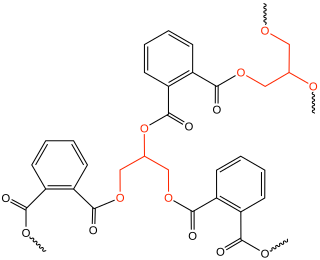
An alkyd is a polyester resin modified by the addition of fatty acids and other components. Alkyds are derived from polyols and organic acids including dicarboxylic acids or carboxylic acid anhydride and triglyceride oils. The term alkyd is a modification of the original name "alcid", reflecting the fact that they are derived from alcohol and organic acids. The inclusion of a fatty acid confers a tendency to form flexible coatings. Alkyds are used in paints, varnishes and in moulds for casting. They are the dominant resin or binder in most commercial oil-based coatings. Approximately 200,000 tons of alkyd resins are produced each year. The original alkyds were compounds of glycerol and phthalic acid sold under the name Glyptal. These were sold as substitutes for the darker-colored copal resins, thus creating alkyd varnishes that were much paler in colour. From these, the alkyds that are known today were developed.
Winsor & Newton is an English manufacturing company based in London that produces a wide variety of fine art products, including acrylics, oils, watercolour, gouache, brushes, canvases, papers, inks, graphite and coloured pencils, markers, and charcoals.
A glaze is a thin transparent or semi-transparent layer on a painting which modifies the appearance of the underlying paint layer. Glazes can change the chroma, value, hue and texture of a surface. Glazes consist of a great amount of binding medium in relation to a very small amount of pigment. Drying time will depend on the amount and type of paint medium used in the glaze. The medium, base, or vehicle is the mixture to which the dry pigment is added. Different media can increase or decrease the rate at which oil paints dry.

White lead is the basic lead carbonate 2PbCO3·Pb(OH)2. It is a complex salt, containing both carbonate and hydroxide ions. White lead occurs naturally as a mineral, in which context it is known as hydrocerussite, a hydrate of cerussite. It was formerly used as an ingredient for lead paint and a cosmetic called Venetian ceruse, because of its opacity and the satiny smooth mixture it made with dryable oils. However, it tended to cause lead poisoning, and its use has been banned in most countries.
Rangsazi Iran - Iran Paint Manufacturing Company - شرکت رنگسازي ايران, was founded in 1939 as the first paint producer in Iran as well as the Middle East. Rangsazi Iran was as of 2008 the top producer in decorative and industrial paints within the country in terms of volume of sales and quality.
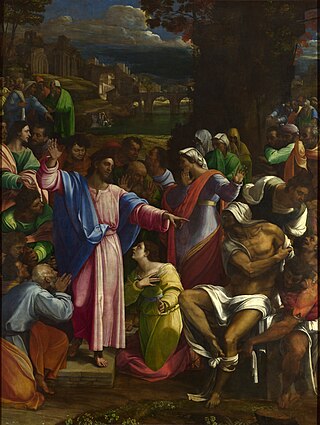
The practice of conserving an unstable painting on panel by transferring it from its original decayed, worm-eaten, cracked, or distorted wood support to canvas or a new panel has been practised since the 18th century. It has now been largely superseded by improved methods of wood conservation.

The conservation and restoration of paintings is carried out by professional painting conservators. Paintings cover a wide range of various mediums, materials, and their supports. Painting types include fine art to decorative and functional objects spanning from acrylics, frescoes, and oil paint on various surfaces, egg tempera on panels and canvas, lacquer painting, water color and more. Knowing the materials of any given painting and its support allows for the proper restoration and conservation practices. All components of a painting will react to its environment differently, and impact the artwork as a whole. These material components along with collections care will determine the longevity of a painting. The first steps to conservation and restoration is preventive conservation followed by active restoration with the artist's intent in mind.

An oil base or oil pedestal is a water, dirt and fat repellent paint, which is applied directly as a coating on the rough plaster to protect it. Mostly it consists of a coating of paint, which is based on alkyd resin and is often applied in staircases, but also in kitchens and bathrooms of old buildings. It is sometimes found in heavy traffic hallways.
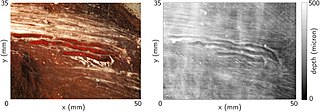
In visual arts, the ground is a prepared surface that covers the support of the picture and underlies the actual painting. Occasionally the term is also used in a broad sense to designate any surface used for painting, for example, paper for watercolor or plaster for fresco.